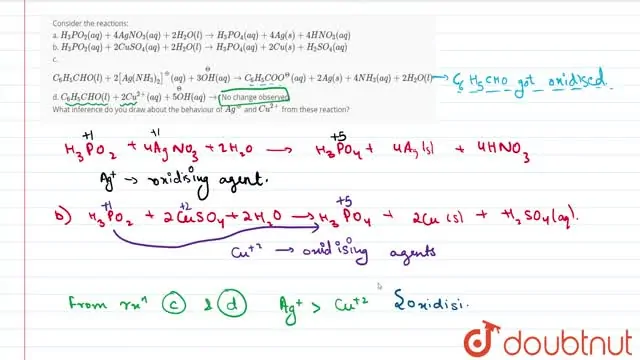Consider the reactions:
a. H3PO2(aq)+4AgNO3(aq)+2H2O(l)→H3PO4(aq)+4Ag(s)+4HNO3(aq)
b. H3PO2(aq)+2CuSO4(aq)+2H2O(l)→H3PO4(aq)+2Cu(s)+H2SO4(aq)
c. C6H5CHO(l)+2[Ag(NH3)2]⊕(aq)+3ΘOH(aq)→C6H5COOΘ(aq)+2Ag(s)+4NH3(aq)+2H2O(l)
d. C6H5CHO(l)+2Cu2+(aq)+5ΘOH(aq)→ No change observed
What inference do you draw about the behaviour of Ag⊕ and Cu2+ from these reaction?
Ag+ and Cu2+ act as oxidising agents in reactions (a) and (b) respectively .
In reaction (c) , Ag+ oxidised C6H5CHO to C6H5COO− , but in reaction (d) , Cu2+ cannot oxidise C6H5CHO .
Hence , we can say that Ag+ is a stronger oxidising agent than Cu2+
Related Playlists
- BOOK - NCERT ENGLISHCHAPTER - REDOX REACTIONSEXERCISE - EXERCISE30videos
REDOX REACTIONS
- BOOK - NCERT ENGLISHCHAPTER - ORGANIC CHEMISTRY- SOME BASIC PRINCIPLES AND TECHNIQUESEXERCISE - EXERCISE40videos
ORGANIC CHEMISTRY- SOME BASIC PRINCIPLES AND TECHNIQUES
- BOOK - NCERT ENGLISHCHAPTER - SOME BASIC CONCEPTS OF CHEMISTRY EXERCISE - All Questions45videos
SOME BASIC CONCEPTS OF CHEMISTRY
Similar Questions
What is the reaction given below, called ?
H2O(l)+H2O(l)⇔H3O+(aq)+OH−(aq)View SolutionIn the reaction : 2Al(s)+6HCl(aq)→2Al3+(aq)+6Cl−(aq)+3H2(g)
View SolutionComplete the following chemical equations :
(i) MnO−4(aq)+S2O2−3(aq)+H2O(l)→1
(ii) Cr2O2−7(aq)+Fe2+(aq)+H+(aq)→View SolutionThe reaction:
BaCl2(aq)+H2SO4(aq)→BaSO4(s)+2HCl(aq) isView SolutionIn which direction will the following equilibria I and II proceed?
I:H2SO4(aq)+NH3(aq)⇔NH+4(aq)+HSO−4(aq)
II:HCO−3(aq)+SO−4(aq)⇔HSO−4(aq)+CO2−3(aq)View SolutionConsider the reaction:
2S2O2−3(aq)+I2(s)→S4O2−6(aq)+2IΘ(aq)
2S2O2−3(aq)+2Br2(l)+5H2O(l)→2SO2−4(aq)+4BrΘ(aq)+10H⊕(aq)
Why does the same reductant, thiosulphate, react differently with iodine and bromine?View SolutionClassify the following redox reactions:
a. N2(g)+O2(g)→2NO(g)
b. 2Pb(NO)3(s)→2PbO(s)+2NO2(g)+12O2(g)
c. NaH(s)H2O(l)→NaOH(aq)+H2(g)
d. 2NO2(g)+2өOH(aq)→NOө2(aq)+NOө3(aq)+H2O(l)View SolutionComplete the following chemical equations :
(i)P4(s)+NaOH(aq)+H2O(l)→
(ii) I−(aq)+H2O(l)+O3(g)→View SolutionComplete the missing components/variables given as x and y in the following reactions
(a) Pb(NO3)2(aq)+2KI(aq)→PbI2(x)+2KNO3(y)
(b) Cu(s)+2AgNO3(aq)→Cu(NO3)2(aq)+x(s)
(c) Zn(s)+H2SO4(aq)→ZnSO4(x)+H2(y)
(d) CaCO3(s)x−−→CaO(s)+CO2(g)View SolutionIn the resction 2NH+4+6NO−3(aq)+4H+(aq)→6NO2(g)+N2(g)+6H2O the reducing agent is
View Solution


